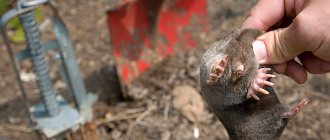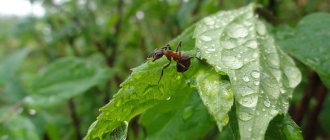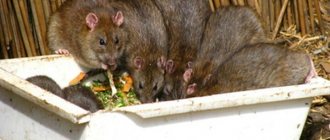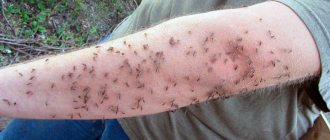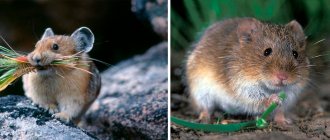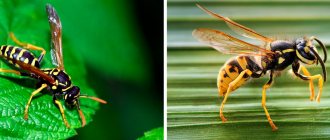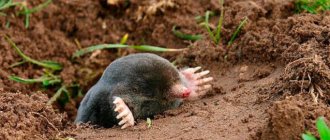Why do snakes appear in the garden plot and how to prevent it
Most of the snakes living in Russia are not dangerous, except that they bite painfully. Of the poisonous ones in the middle zone, the most common viper you can find is the common viper. Snakes prefer quiet, warm and damp places. In gardens they settle in:
- the intertwined roots of old fruit trees;
- dense thickets of bushes, tall grass;
- rotten stumps;
- woodpiles;
- stacked building materials;
- heaps of garbage or compost;
- basements, sheds, cellars.
When meeting a snake, many people immediately panic and can no longer distinguish a harmless snake from a poisonous viper.
Man himself is to blame for the migration of snakes closer to “civilization.” In the process of deforestation, their natural habitat is destroyed. It’s easy to make your site unattractive to them:
- mow the grass regularly;
- uproot thickets of bushes, old trees, and stumps left behind;
- eliminate deposits of garbage and other untidy “debris”;
- install the fence on a concrete base or stretch a fine-mesh metal mesh underneath it.
Snakes may well choose dense thickets of grass as their home
Video: why snakes settle in garden plots and what to do when meeting a reptile
Snakes in the garden: an invisible danger
A snake attacks a person only in two cases - if it is frightened or provoked. However, this does not make things any calmer. Not all adults, having heard a suspicious rustling in the bushes next to their bare feet, are able to quickly cope with the rush of adrenaline, allowing the snake to crawl on its way. If we are talking about children, then their meeting with any of the representatives of this species is extremely undesirable. After all, fright can cause a child to suffer serious mental trauma, not to mention the deadly danger of a snake bite for a child’s body.
Viper warning color
Reptiles are predominantly nocturnal, which complicates their detection and identification. However, the presence of snakes in the area is always noticeable to an experienced eye. Their main food is rodents, which are found all over the place. Therefore, if no one eats the garden crops you planted, there are no hedgehogs in the vicinity of your dacha, and you yourself do not have a cat or dog, most likely there are snakes on your site. They live in burrows, which they prefer to dig in swampy, shaded vegetation and therefore always cool and slightly moist soil. In addition, snakes periodically shed their skin. Its remains, which are called “creeps,” can be found in their habitats and migration areas - in thick grass, bushes, near reservoirs and rivers, in areas with high soil moisture, etc.
Snake crawl
The most dangerous time in terms of encounters with the snake brethren is early to mid-summer. It is then that the breeding season begins for most species that are found in our country, and they themselves become very irritable.
Traps and industrial repellers
Snakes are attracted to the smell of warm milk and many berries, especially strawberries. But setting traps for them is a bad idea. Firstly, it is impossible to predict how much time you will have to spend “in ambush”. Secondly, the caught snake must be destroyed. For most, this is unacceptable purely psychologically, for reasons of humanity. Also keep in mind that dying females release specific pheromones, indicating their readiness to mate. Instead of one snake, you will soon have to deal with a dozen of its relatives.
A dead snake should not be touched with bare hands. The same applies to the skin shed during the molting process. The characteristic smell practically “eats” into the skin, attracting other snakes.
If you find snakeskin in your area, put on rubber gloves, seal it in a plastic bag if possible, and throw it away somewhere away from your home.
A much more effective solution to the problem is special repellers. The device is extremely simple and reliable. The price is affordable - in the range of 800–2500 rubles.
It just needs to be stuck into the soil near an area that snakes might potentially like. One device covers an area of 300–600 m², the power source is solar panels. A positive effect is provided by ultrasound, vibration or a combination of both. Snakes have very developed and sensitive hearing organs, but they perceive noise not as sound, but as vibration. They cannot adapt to the waves generated by the device due to their changing frequency, so they are forced to leave the area.
The simplicity of the design of snake repellers largely determines their reliability
Popular models:
- Weitech-WK677 Solar;
- EcoSniper LS-107;
- HELP from snakes;
- Tornado B03.01;
- Uniel UDR-S20.
Video: review of different models of snake repellers
Homemade weather vanes and rattles give a similar result, but, of course, the effect is much weaker. Also, snakes will not settle in an area where a lawn mower, trimmer, or circular saw is regularly used.
If you regularly mow your garden with a lawn mower or trimmer, you will almost certainly not have problems with snakes.
How to get rid of vipers in your summer cottage
These snakes do not like noisy and inedible neighbors like humans, plus cleared areas. If your site is not overgrown with weeds, you visit it often, there are no abandoned dachas in the area, and dangerous “residents” still do not leave, then you need to analyze and eliminate the reasons for such love for the land. After killing the viper, the body, as well as the top layer of soil on which it died, must be carried away as far as possible. Snakes eat each other, and the smell of a helpless, killed relative will be very attractive to them.
Find out how to get rid of mice.
Powerful Chemicals
Using poisons (along with killing) is the least effective way to control snakes. Bait will not work; snakes need live prey. They endure prolonged hunger relatively easily. But such substances are unsafe for the environment, human health and pets.
Special repellent mixtures, which can also be bought in agricultural stores, based on essential oils and other strong-smelling substances (naphthalene, sulfur):
- Nature Products Snake Repelling Granules by Dr. T's;
- 6400 Snake Shield Snake Repellent by Havahart;
- 5200 All Out Snake Repellent from Sweeney's.
Nature Products Snake Repelling Granules by Dr. T's, like other snake repellents, is a product of questionable effectiveness.
They are scattered around the perimeter of the site and “surrounded” by places potentially attractive to reptiles. But they only act when they hit the snakes' sensory receptors. Additionally, most are made in the USA and are designed to control native snakes such as rattlesnakes. And (judging by the reviews) the effectiveness of repellents is 50/50 at best.
A pungent odor that is unacceptable to snakes is given by:
- diesel fuel;
- kerosene;
- petrol;
- used machine oil;
- naphthalene.
When planning to fight snakes with chemicals, keep in mind that you can cause great harm to the soil and groundwater in the area
Shallow grooves are formed at the boundaries around the area and these chemicals are spilled or dry mothballs are scattered. But keep in mind that after rain they will be washed away, and it is difficult to predict where the water, which is very harmful to the soil, will flow.
When working with any chemicals, take care of protective equipment (goggles, gloves, respirator, hat, long sleeves, waterproof shoes). Carry out processing without the presence of children and pets.
Chemical snake repellents with mothballs and sulfur
Naphthalene
Firstly, these balls contain a very strong neurotoxin. If it gets into the mouth of a child or dog, all this could end badly. Secondly, science has not been able to prove its effectiveness against snakes. Scientists directly state: “Naphthalene is not a snake repellent.” If you don't believe the scientists, just watch the MythBusters episode. Adam Savage and company also destroyed this legend. And laboratory work with pure mothballs has shown that it is not a hindrance for snakes. Scientists Gary J. San Julian and David K. Woodward conducted an experiment to prove this: they placed a snake in a closed box, sprinkled repellent in front of it, and placed bait behind it - and almost always the animal ignored the mothball barrier.
Sulfur
Sulfur is not often used in its pure form against snakes. More often it is mixed with the same naphthalene. We can confidently write one thing about this mixture: it stinks strongly and is easily washed off by rain. It is possible that a certain concentration of the two ingredients could affect snakes. There is evidence of “limited effectiveness” of a number of registered drugs based on naphthalene and sulfur. This is also confirmed by the fact that a number of repellents “sulfur + naphthalene” still received a state license. They work best on rattlesnakes and checkered garter snakes, but... with caveats.
Snake-A-Way, made from 7% naphthalene and 28% sulfur, for example, has not passed laboratory testing. Rex E. Marsh of the University of California placed a strip of repellent on the floor of a room and introduced snakes into it one at a time. According to statistics, every second snake crossed the barrier more than once. And Snake-a-Way’s competitors have not earned their reputation as “universal repellents.”
Natural enemies of snakes
The first association for many is Rudyard Kipling and his “Rikki-Tikki-Tavi”. Getting a mongoose in Russia is quite problematic, but snakes also have other natural enemies:
- Jerzy. It will help cope not only with reptiles, but also with moles, rats, and toads. Plates with milk and meat scraps left on the street will help to lure them to the site. But the berry harvest may suffer from them. You can also simply “drink” hedgehogs, although this is inhumane. Wine, beer, and other weak alcohol are real doping for them. The fact that a drunken hedgehog is a real “deadly weapon” against snakes was discovered back in the Middle Ages.
Hedgehogs can cause some inconvenience to the gardener, but they are very valuable assistants in the fight against snakes, so it’s worth thinking about attracting them to the site
- Cats and dogs. But pets hunt less actively than hedgehogs, for whom snakes are food. It's more a matter of mood. The exception is dog breeds bred specifically for hunting (Jagdterrier, Australian terrier). And cats have a habit of “bragging” to their owner about their prey, which is very unpleasant.
The Jagdterrier is a hunting breed of dog that also attacks snakes.
What to do if a snake bites
- It is imperative to remember that the bite site is not cauterized, pierced or pinched with a tourniquet.
- It is necessary to reduce the concentration of poison in the blood; to do this, it should be sucked out. This must be done in the first 10 minutes. If you suck out the poison with your mouth, be sure to spit it out, and then rinse your mouth with a solution of potassium permanganate or water. When swelling has already appeared at the site of the bite, you should stop suctioning.
- Take an allergy medicine (suprastin, zodak).
- Place the victim horizontally and motionless.
- The antidote should be administered within 60 minutes, and in no case later. During transportation, the bitten part of the body must remain motionless.
Although snakes are not pleasant to be around, they are important to the ecosystem. If they decide to settle on the site, it is better to get rid of them using humane methods. It is worth organizing conditions that will not be pleasant for them, then the snakes will find another place to live. This will be more humane and effective than killing them.
Watch the video! How to get rid of snakes
Must know: first aid for a victim of a poisonous snake bite
These rules need to be memorized. They will be useful to you if you have just discovered these uninvited guests in your possessions and have not yet begun to fight them. Everyone is at risk of being bitten by a snake, so remember what the victim needs to do.
- Drink plenty of water, it will help speed up the removal of poison from the body and slow down its absorption. At the same time, try to move as little as possible and not panic, so as not to cause tachycardia.
- Avoid drinking tea and coffee: these drinks speed up blood circulation. Drinking alcohol is strictly prohibited if you are bitten by a poisonous snake. You can’t even treat a wound with alcohol: ethyl thins the blood, speeds up its flow through the vessels, and the poison quickly spreads throughout the body.
- Do not cover the wound with a bandage: this can cause harmful substances to stagnate at the site of the bite, which will lead to tissue infection.
- You can immediately after a bite carefully suck out the blood and poison from the wound. But it is worth remembering that any wound on the oral mucosa, and even a decayed tooth, can serve as a path for poison to enter the body. At the same time, swallowed poison is not at all dangerous to the body: the mucous membrane of the stomach and esophagus is immune to this substance.
- After the poison is removed from the wound, the edges of the bites can be treated with brilliant green, iodine or alcohol. But in no case should you use oxidizing substances, for example, potassium permanganate, as well as alkalis or objects heated on fire.
- A person who has been bitten needs to lie down so that his head is lower in relation to his body: this makes it easier for blood to flow to the brain.
After all preliminary measures have been taken, be sure to take the victim to the hospital, where he will be injected with the appropriate serum.
Keep a first aid kit with the necessary supplies at your dacha
Always keep a first aid kit nearby, containing the following items:
- antipyretics;
- painkillers;
- anti-inflammatory;
- antiallergic;
- drugs for the cardiovascular system and high blood pressure;
- antibiotics.
If there are too many snakes on your property, or you are afraid to get rid of them yourself, then it is better to contact herpetologists. But if you are in the mood for a serious fight, then our advice will be useful to you.
Looking for a place in the sun
Despite the high technologies used in agriculture, people continue to expand their holdings.
Unfortunately, this leads to disruption of ecosystems. For example, in Alaska, bears walk the streets. And in India, tigers attack people. In a similar way, snakes end up on the territory of country houses, especially if the following are located next to them:
- forest;
- lake;
- abandoned estates;
- wastelands overgrown with grass and shrubs.
In search of food, reptiles involuntarily crawl into “private” territory, which is full of delicious prey. Typically, snakes feed on:
- eggs;
- rodents;
- large insects;
- birds.
All these components can be found in abundance among farmers, who often raise chickens or pigeons. In addition, no home is safe from the presence of mice, a favorite delicacy of crawling creatures. This is how snakes appear at the dacha, fighting for a place in the sun. Most often, animals settle in compost or garbage pits. They can be found in bushes that are rarely cleared. Sometimes the creatures are accidentally brought in with construction materials. Let's get to know the dangerous guests better.
We begin to drive out snakes: cleanliness is the key to success
Thorough cleaning of the entire dacha area will certainly help you get rid of snakes. For a creeping adder, anything can be an attractive refuge: fragments of boards, slate, logs, heaps of branches and debris. Anything unnecessary or unused must be removed off-site or destroyed.
Maintain order in your summer cottage so that snakes have nowhere to nest.
Regularly mow the grass in your garden or lawn. Dense tall thickets are an excellent place for a snake. By the way, a running lawn mower creates such noise that snakes, due to discomfort, will be forced to move to where it is quieter and calmer. Therefore, regular use of such a tool will only benefit both the garden and you: the snake will crawl away to look for a place with taller grass, where it is easy to hide from the sun and prying eyes.
Snakes love to make their nests in compost heaps, where optimal temperature conditions are created for laying eggs. Therefore, such places should be as far from home as possible. The snake will defend its nesting site with its offspring to the last, so it is better to prevent its appearance than to try to get rid of an entire family.
Note. Snakes are especially dangerous in the spring, when the period of molting and egg laying begins. At the end of summer - in August - snakes become active again.
By the way, snakes can be useful for a garden plot. They feed on toads, small rodents and moles, which are very harmful to your garden beds. If you are not afraid of these amphibians, then they can become your allies (if we are talking about non-venomous snakes). But remember that snakes love strawberries and wild strawberries. You will have to choose: either you have a rich harvest of these berries, or the snakes and copperheads destroy other pests.

